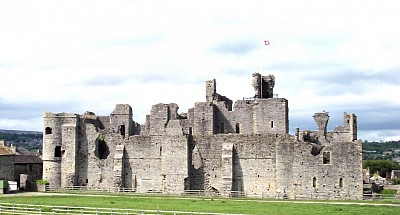Middleham Castle and Middleham Manor
This is Williams Hill, a motte and bailey which predates Middleham Castle. It was built circa 1090 and is 160 feet by 115 feet, surrounded by a ditch 20 feet wide and 9 feet deep. From the top you get fine views into Coverdale and Wensleydale, making it a good position to defend. Middleham was part of the Honour of Richmond which was given to Count Allan Rufus of Brittany after the Norman Conquest. Middleham was put under the control of Alan's half brother, Ribald.
The motte and bailey castle was held by Ribald and his son Ralph, but the next generation, Robert, began to build the present castle in stone. It was built in two stages with a strong inner keep and outer curtain wall with a drawbridge over a moat. Later modifications added rooms on the inside of the curtain wall which necessitated windows, which made it less defensible, but more desirable as a residence. The Castle is looked after by English Heritage and is open to the public. In May the walls of the castle are covered in pink flowers and it looks delightful, they also decorate the head and foot of this page.
When there were no more male heirs from the line of Ribald, the castle went to Mary who had married Robert de Neville. She inherited in 1270 and the castle remained in the hands of the Nevilles until the time of Richard III. Anne Neville , daughter of Richard Earl of Warwick, married Richard Duke of Gloucester, who became King Richard III. After his death in 1485 the Castle remained in the hands of the Crown until 1628.
Henry Lyndley, a knight of Middleham Castle made his will as he lay dying in the Castle in 1599. during the day of the 17th of November he called various people into his chamber and gave them bequests, each of which was witnessed. His wife was Jeromima was the first to be mentioned, next were nephews, then at about eleven o'clock he remembered his servant John Starkey who got £100, next was John Cox who got the Lodge in the West Park of Middleham, grazing rights and some cows , then at one o'clock he remembered some more servants who got money, then his sister Mrs Stubbes got £50 and lastly all his women servants got £5 each.
Middleham Castle was an important administrative centre for the Crown lands in the North of England. In the Tudor period the Lordship of Middleham covered an area from Bowes on the A66, through Arkengarthdale, along Wensleydale and over to the borders of Langstrothdale and Bishopdale and into Wharfedale and Coverdale.
During this period one of the terms of being a tenant of the Lordship was that you had to do Border Service if there was a threat of invading Scots. With the accession of James VI of Scotland as James I of England the terms of tenure had to be renegotiated, which led to many protests from tenants who had to pay to get new leases. In 1628 Charles I, being deeply in debt, sold the Manor of Middleham to the City of London. Middleham Manor was purchased for the value of 28 years rent , which was over £20,000. There then followed many, many disputes between the tenants and their new Lord of the Manor, who was the City of London. There were about 1,200 tenants, and they became so troublesome that the City asked Major Norton of St Nicholas, Richmond, to intervene in 1654.The City wanted to sell property as each lease expired, but not all the tenants wished to or were able to purchase. Some tenants challenged the City for not renewing a lease, or not allowing a widow to continue, as was customary. There was also the political angle that the City supported the Parliamentarians in the Civil War and some tenants who were Royalists had their goods sequestered. After a lengthy Court case it was found that the City were bound to renew the leases as each expired, thus denying the City the benefit of their purchase of the Manor. Some tenants did purchase, and this was why Middleham Manor became fragmented. Privately owned Freeholds became the residences of gentlemen who improved or rebuilt , leaving many fine houses in Middleham.
The City of London decided to sell the Manor of Middleham, though it was reduced in size, and in 1661 - 1662 it was purchased by the Wood family of Littleton in Middlesex. They owned Middleham until 1889 when it was purchased by the Cunliffe Lister family of Swinton near Masham. The Wood family were never resident in Middleham but employed a succession of stewards to administer their estate, keep accounts, collect rents and their correspondence tells us what happened in Middleham. One thing that they did was contract with a company of demolition men to take apart the castle. In 1663 a contract was made between Edward Wood of London and Godfrey Boore and Edmund White of Chesterfield in Derbyshire, that for £1,000 they could take away as much stone, timber, metal work and glass as they could within five years. The Wood family then stocked the Parks with sheep , took rents and became involved in the local mines.
In 1889 the Manor of Middleham was sold again and purchased by the Cunliffe Lister family, who already had purchased the estate at Swinton near Masham and the Jervaulx estate, with money made from manufacturing textiles in Bradford. By 1925 the family were considering selling what was left of the Manor of Middleham, and as most tenants expressed an interest in purchasing their own properties, this would have left only the Castle. It was therefore offered to the Office of Works who took over around 1927. They then employed labourers to clear the site and dig out the moat. Newspapers of the 1930s have tantalizing reports and photographs of the finds - pottery, painted glass, ladies slippers, ornaments, spurs, etc . Where are they now ?






